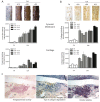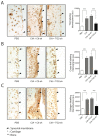Transglutaminase 2 cross-linking activity is linked to invadopodia formation and cartilage breakdown in arthritis
- PMID: 22762273
- PMCID: PMC3580551
- DOI: 10.1186/ar3899
Transglutaminase 2 cross-linking activity is linked to invadopodia formation and cartilage breakdown in arthritis
Abstract
Introduction: The microenvironment surrounding inflamed synovium leads to the activation of fibroblast-like synoviocytes (FLSs), which are important contributors to cartilage destruction in rheumatoid arthritic (RA) joints. Transglutaminase 2 (TG2), an enzyme involved in extracellular matrix (ECM) cross-linking and remodeling, is activated by inflammatory signals. This study was undertaken to assess the potential contribution of TG2 to FLS-induced cartilage degradation.
Methods: Transglutaminase (TGase) activity and collagen degradation were assessed with the immunohistochemistry of control, collagen-induced arthritic (CIA) or TG2 knockdown (shRNA)-treated joint tissues. TGase activity in control (C-FLS) and arthritic (A-FLS) rat FLSs was measured by in situ 5-(biotinamido)-pentylamine incorporation. Invadopodia formation and functions were measured in rat FLSs and cells from normal (control; C-FLS) and RA patients (RA-FLS) by in situ ECM degradation. Immunoblotting, enzyme-linked immunosorbent assay (ELISA), and p3TP-Lux reporter assays were used to assess transforming growth factor-β (TGF-β) production and activation.
Results: TG2 and TGase activity were associated with cartilage degradation in CIA joints. In contrast, TGase activity and cartilage degradation were reduced in joints by TG2 knockdown. A-FLSs displayed higher TGase activity and TG2 expression in ECM than did C-FLSs. TG2 knockdown or TGase inhibition resulted in reduced invadopodia formation in rat and human arthritic FLSs. In contrast, increased invadopodia formation was noted in response to TGase activity induced by TGF-β, dithiothreitol (DTT), or TG2 overexpression. TG2-induced increases in invadopodia formation were blocked by TGF-β neutralization or inhibition of TGF-βR1.
Conclusions: TG2, through its TGase activity, is required for ECM degradation in arthritic FLS and CIA joints. Our findings provide a potential target to prevent cartilage degradation in RA.
Figures





Similar articles
-
Paeoniflorin suppresses inflammatory mediator production and regulates G protein-coupled signaling in fibroblast-like synoviocytes of collagen induced arthritic rats.Inflamm Res. 2008 Aug;57(8):388-95. doi: 10.1007/s00011-007-7240-x. Inflamm Res. 2008. PMID: 18787778
-
Transglutaminase-2 differently regulates cartilage destruction and osteophyte formation in a surgical model of osteoarthritis.Amino Acids. 2009 Apr;36(4):755-63. doi: 10.1007/s00726-008-0129-3. Epub 2008 Jun 27. Amino Acids. 2009. PMID: 18584285
-
Snail Is a Critical Mediator of Invadosome Formation and Joint Degradation in Arthritis.Am J Pathol. 2016 Feb;186(2):359-74. doi: 10.1016/j.ajpath.2015.10.021. Epub 2015 Dec 17. Am J Pathol. 2016. PMID: 26704941
-
Identification and characterization of substrates crosslinked by transglutaminases in liver and kidney fibrosis.Anal Biochem. 2020 Sep 1;604:113629. doi: 10.1016/j.ab.2020.113629. Epub 2020 Feb 13. Anal Biochem. 2020. PMID: 32061735 Review.
-
Transglutaminase 2 in cartilage homoeostasis: novel links with inflammatory osteoarthritis.Amino Acids. 2017 Mar;49(3):625-633. doi: 10.1007/s00726-016-2305-1. Epub 2016 Aug 10. Amino Acids. 2017. PMID: 27510997 Free PMC article. Review.
Cited by
-
Transglutaminase 2 in human diseases.Biomedicine (Taipei). 2017 Sep;7(3):15. doi: 10.1051/bmdcn/2017070315. Epub 2017 Aug 25. Biomedicine (Taipei). 2017. PMID: 28840829 Free PMC article.
-
Targeting MyD88 Downregulates Inflammatory Mediators and Pathogenic Processes in PBMC From DMARDs-Naïve Rheumatoid Arthritis Patients.Front Pharmacol. 2021 Dec 23;12:800220. doi: 10.3389/fphar.2021.800220. eCollection 2021. Front Pharmacol. 2021. PMID: 35002734 Free PMC article.
-
ECM Cross-Linking Regulates Invadopodia Dynamics.Biophys J. 2018 Mar 27;114(6):1455-1466. doi: 10.1016/j.bpj.2018.01.027. Biophys J. 2018. PMID: 29590602 Free PMC article.
-
Osthole regulates N6-methyladenosine-modified TGM2 to inhibit the progression of rheumatoid arthritis and associated interstitial lung disease.MedComm (2020). 2023 Feb 22;4(2):e219. doi: 10.1002/mco2.219. eCollection 2023 Apr. MedComm (2020). 2023. PMID: 36845072 Free PMC article.
-
TGM2 knockdown reverses cisplatin chemoresistance in osteosarcoma.Int J Mol Med. 2018 Oct;42(4):1799-1808. doi: 10.3892/ijmm.2018.3753. Epub 2018 Jul 4. Int J Mol Med. 2018. PMID: 30015899 Free PMC article.
References
-
- Nanki T, Nagasaka K, Hayashida K, Saita Y, Miyasaka N. Chemokines regulate IL-6 and IL-8 production by fibroblast-like synoviocytes from patients with rheumatoid arthritis. J Immunol. 2001;167:5381–5385. - PubMed
-
- Garcia-Vicuna R, Gomez-Gaviro MV, Dominguez-Luis MJ, Pec MK, Gonzalez-Alvaro I, Alvaro-Gracia JM, Diaz-Gonzalez F. CC and CXC chemokine receptors mediate migration, proliferation, and matrix metalloproteinase production by fibroblast-like synoviocytes from rheumatoid arthritis patients. Arthritis Rheum. 2004;50:3866–3877. doi: 10.1002/art.20615. - DOI - PubMed
-
- Remmers EF, Lafyatis R, Kumkumian GK, Case JP, Roberts AB, Sporn MB, Wilder RL. Cytokines and growth regulation of synoviocytes from patients with rheumatoid arthritis and rats with streptococcal cell wall arthritis. Growth Factors. 1990;2:179–188. - PubMed
Publication types
MeSH terms
Substances
Grants and funding
LinkOut - more resources
Full Text Sources
Other Literature Sources

